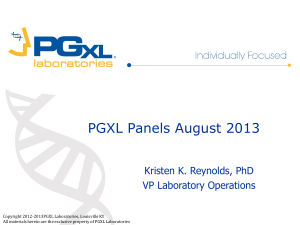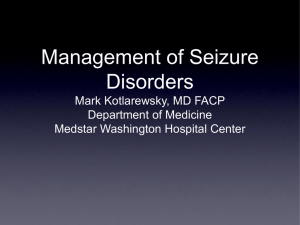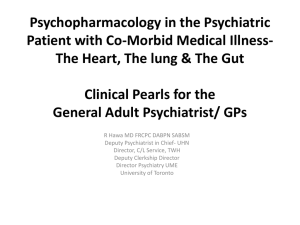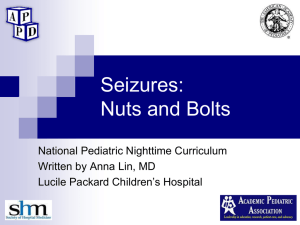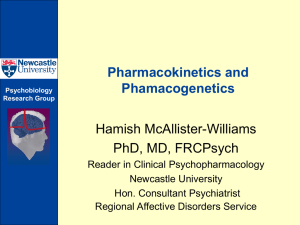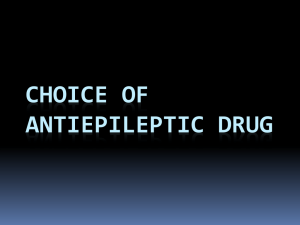202 Pharmacokinetics.. - University Psychiatry
advertisement
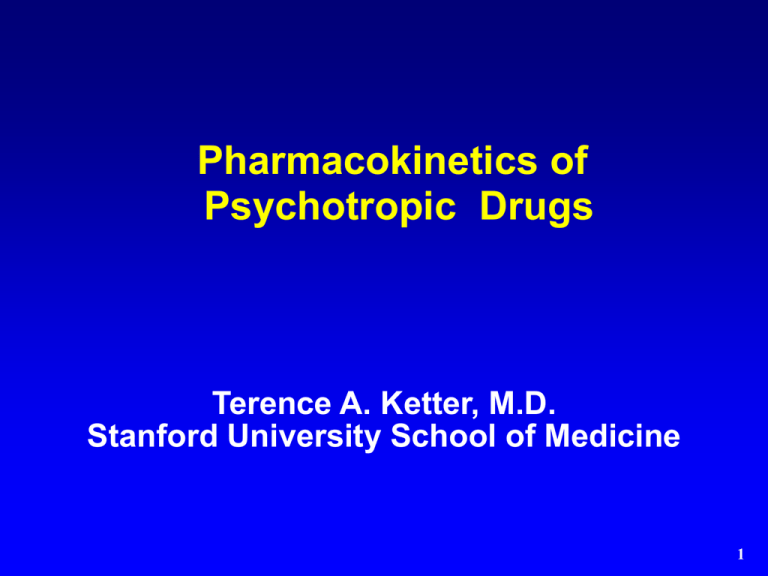
Pharmacokinetics of Psychotropic Drugs Terence A. Ketter, M.D. Stanford University School of Medicine 1 Teaching Points Knowledge of pharmacokinetics is crucial for optimal pharmacotherapy, particularly in patients receiving combinations of medications. Most clinically significant pharmacokinetic drug interactions involve induction or inhibition of metabolism. Pharmacokinetic drug interactions are becoming increasingly predictable, due to advances in knowledge of the genetics of metabolic enzymes. 2 Pre Lecture Exam Question 1 1. Key pharmacokinetic parameters include: (choose one) A. B. C. D. E. F. Volume of distribution (V) Half life (t1/2) Clearance (Cl) Therapeutic index All of the above A, B, and C 3 Question 2 2. After discontinuation, how long does it take to completely clear a drug? (choose one) A. B. C. D. Clearance x half-life 2 x half-life 5 x half-life Volume of distribution x clearance 4 Question 3 3. The two most important cytochrome P450 isoforms mediating drug interactions in psychiatric patients receiving combination therapies are: (choose two) A. 1A2 B. 2C9/10 C. 2C19 D. 2D6 E. 2E1 F. 3A3/4 5 Question 4 4. Which of the following drugs is NOT an enzyme inducer? (choose one) A. B. C. D. E. F. Carbamazepine Valproate Oxcarbazepine Phenytoin Phenobarbital Primidone 6 Question 5 5. Which of the following drugs decrease plasma concentrations of hormonal contraceptives? (choose one) A. B. C. D. E. F. Carbamazepine Oxcarbazepine Topiramate Phenytoin Phenobarbital All of the above 7 Question 6 6. Which of the following drugs is NOT an enzyme inhibitor? (choose one) A. B. C. D. E. F. Lithium Bupropion Fluoxetine Valproate Cimetidine Erythromycin 8 Question 7 7. Which of the following drugs robustly increases plasma concentrations of lamotrigine? (choose one) A. B. C. D. E. Carbamazepine Valproate Cimetidine Gabapentin Phenytoin 9 Question 8 8. Which of the following drugs have almost exclusively renal excretion? (choose one) A. B. C. D. E. Gabapentin Valproate Lithium Carbamazepine A and C 10 Question 9 9. Monoamine oxidase inhibitor combination therapy is limited by: A. B. C. D. E. F. Side effects (low to low-moderate therapeutic index) Serious pharmacodynamic drug interactions Allergic reactions (rashes) Their exclusively renal excretion A and B None of the above 11 Question 10 10. Which of the following benzodiazepines has least potential for drug interactions? A. B. C. D. Diazepam (a 2-keto-benzodiazepine) Alprazolam (a triazolo-benzodiazepine) Flurazepam (a 2-keto-benzodiazepine) Lorazepam (a 3-hydroxy-benzodiazepine) 12 Outline * • CONCEPTS Pharmacokinetics, Pharmacodynamics • CYTOCHROME P450 Isoforms, Substrates, Inhibitors, Inducers • MOOD STABILIZERS Li, CBZ, VPA, lamotrigine • ANTIDEPRESSANTS SSRIs, SNRIs, bupropion, TCAs, MAOIs • OTHER AGENTS Anxiolytics, Antipsychotics, Anticonvulsants, Ca blockers 13 * PHARMACOKINETICS •Time course of drug absorption, distribution, metabolism & excretion •Drug transport to & from receptors •What the body does to the drug 14 * PHARMACODYNAMICS • Relationships between drug concentrations & responses • Drug activity at receptors • What the drug does to the body 15 * PHARMACOKINETIC CONCEPTS CONCEPT DEFINITION V Volume needed to contain drug at concentration same as plasma (vol of distrib) t1/2 Time for [drug] to 50% Cl Volume of blood cleared of drug per unit time (half life) (clearance) 16 * PHARMACOKINETIC CONCEPTS CONCEPT RELEVANCE V (vol of distrib) Extracirculatory distribution (binding, lipophilicity) Loading dose (Load with V x[desired conc. change]) t1/2 Time to steady state = 5 x t1/2 (half life) (t1/2 = .7 x V / Cl) Cl Steady state concentration (clearance) (Css = dose x dosing interval x F / Cl) 17 PHARMACOKINETIC CONCEPTS CONCEPT EXAMPLE V Li - 1 L / kg; TCAs - 10 L / kg (vol of dist) (dialysis effective; dialysis ineffective) VPA - 0.2 L / kg (Load with 0.2 L/kg x 100 mg/L = 20 mg/kg) t1/2 (half life) fluoxetine - 5 wk MAOI wait venlafaxine - 2 wk MAOI wait Cl (clearance) [Li] in renal failure [diazepam] in liver failure 18 * ABSORPTION • Bioavailability = % reaching circulation as compared to IV (F = absorption - first pass metabolism) • Affected by food ( sertraline, ziprasidone; nefazodone absorption) • Affected by enteric/hepatic metabolism (tyramine - MAO; terfenadine - CYP3A4) • Speed affected by enteric motility ( with metoclopramide, with TCAs) • Speed affected by formulation (solution > suspension > capsule > tab > enteric coated tab) 19 DISTRIBUTION * • Lipophilicity & binding • Many drugs 80 - 95% protein bound – Albumin - acids – 1-acid glycoprotein - bases, neutral – Lipoproteins - bases, neutral • Binding profiles – Alb: VPA, PHT, diazepam – Alb + 1AG: CBZ, verapamil – Alb + 1AG + LP: CPZ, TCAs • binding in renal d. & hyperthyroidism 20 * EXCRETION Rate = filtration + secretion - reabsorption • Filtration (glomerulus) – Affected by binding interactions – in renal disease • Secretion (proximal tubule) – Drugs compete for active transport • Reabsorption (proximal > distal tubule) – Passive (high for lipophilic drugs) – Thiazides Li & Na reabsorption – Acidifying urine base reabsorption 21 METABOLISM * PHASE I - Introduce functional groups • Oxidation - Hydroxylation - alprazolam - Dealkylation - diazepam - Deamination - amphetamine - Sulfoxidation - chlorpromazine • Reduction - clonazepam • Hydrolysis - acetylsalicylate PHASE II - Form polar derivatives-CONJUGATION • Glucuronidation (UGTs)- oxazepam • Sulfation (SULTs) - acetaminophen • Methylation - norepinephrine • Acetylation (NATs) - clonazepam, phenelzine 22 METABOLITES COMPARED TO PARENT DRUGS • Longer t1/2 • More water soluble • Generally less active , but can be more active (hydroxylated, demethylated) • Pharmacodynamics may be - Similar (CBZ-E cf CBZ) - Different (m-CPP anxiogenic cf trazodone anxiolytic) 23 ACTIVE METABOLITES carbamazepine valproate carbamazepine-10,11-epoxide oxcarbazepine monohydroxyderivitive (MHD) 2-ene-valproate, 4-ene-valproate (toxic) amitriptyline nortriptyline, hydroxynortiptyline IMI/DMI imipramine desipramine, hydroxyIMI and DMI amoxapine hydroxyamoxapine fluoxetine norfluoxetine sertraline N-desmethylsetraline (±) citalopram di/desmethylcitalopram O-desmethylvenlafaxine bupropion hydroxybupropion m-chlorophenylpiperazine (m-CPP) venlafaxine trazodone 24 ACTIVE METABOLITES diazepam desmethyldiazepam desmethyldiazepam hydroxyalprazolam chlorpromazine haloperidol loxapine clozapine hydroxyrisperidone N-desmethyldiazepam clorazepate Nchlordiazepoxide Nalprazolam aphaflurazepam desalkylflurazepam buspirone pyrimidinylpiperazine (1-PP) hydroxychlorpromazine thioridazine mesoridazine reduced haloperidol amoxapine desmethyclozapine (±) risperidone 9aripiprazole dehydo- 25 PHARMACODYNAMIC CONCEPTS CONCEPT DEFINITION / RELEVANCE Therapeutic index Efficacy relative to toxicity Dose-response curve Linear, sigmoidal, curvilinear relationships Tolerance Withdrawal Discontinuation effects Response latency Delay to onset of effects therapeutic or adverse responses with time 26 PHARMACODYNAMIC CONCEPTS CONCEPT EXAMPLE Therapeutic index High for SSRIs, low for Li Dose-response curve Curvilinear for nortriptyline (therapeutic window) Tolerance BZ (sedation, anticonvulsant) opiates (analgesia) Withdrawal BZ (insomnia, anxiety) Response latency BZ - minutes Li, CBZ, VPA - days to wks 27 * DRUG INTERACTIONS PHARMACOKINETIC - Absorption - Distribution - Metabolism - Excretion PHARMACODYNAMIC - Direct - at same receptor site (AMI + CPZ anticholinergic toxicity) - Indirect - at different receptor sites (MAOI + SSRI serotonin toxicity) 28 * INTERACTION POTENTIAL • • • • • Low therapeutic index Long half-life Nonlinear kinetics Active metabolites Potent metabolic inhibition / induction • Single metabolic route • CYP2D6, CYP3A4,5,7 29 * P450 NOTATION CYP2D6 CYP - CYtochrome P (protein) 450 (wave length CO absorption) 2 - family (> 40% homology) D - subfamily (> 55% homology) 6 - gene 30 * KEY ISOFORMS FOR DRUG METABOLISM ISOFORM SUBSTRATES CYP1A2 TCAs,cloz,olanz CYP2C9/10 phenytoin,THC S-warfarin CYP2C19 INHIBITORS cipro fluvoxamine INDUCERS Cig smoke,omep fluvoxamine rifam,barb fluox,fluvox rifampin BZs,TCAs CYP2D6 TCAs,parox,mirtaz venla, ±fluox CYP2E1 parox,fluox ±fluvox, ±sertra disulfiram Etoh,INH Etoh CYP3A4,5,7 BZs,CBZ Sertraline Nefazodone TCAs, mirtaz Ca blockers Oral contraceptives fluoxetine fluvoxamine nefazodone diltiazem verapamil macrolides CBZ phenytoin phenobarb rifampin St John’s wort 31 * CYP2D6 SUBSTRATES atomoxetine duloxetine ± fluoxetine ± mirtazapine paroxetine venlafaxine 2° & 3° tricyclics (hydroxylation) trazodone ± clozapine haloperidol fluphenazine perphenazine risperidone thioridazine codeine mexiletine IC antiarrhythmics blockers INHIBITORS INDUCERS bupropion fluoxetine ± fluvoxamine paroxetine ± sertraline moclobemide fluphenazine haloperidol perphenazine thioridazine - amiodarone cimetidine methadone quinidine Ritonavir et al 32 * CYP3A4,5,7 SUBSTRATES ± citalopram ± mirtazapine nefazodone reboxetine sertraline 3° tricyclics (demethylation) alprazolam diazepam midazolam triazolam buspirone CBZ Ca blockers H1 blockers local anesthetics macrolides quinidine steroids INHIBITORS INDUCERS fluvoxamine CBZ phenobarbital phenytoin nefazodone diltiazem verapamil cimetidine imidazoles macrolides naringenin dexamethasone rifampin 33 INHIBITION PROFILES POTENCY highest CYP2D6 CYP3A4,5,7 quinidine paroxetine fluoxetine bupropion ketoconazole clarithromycin nefazodone sertraline fluvoxamine fluvoxamine nefazodone venlafaxine erythromycin ketoconazole sertraline desmethylsertraline intermediate lowest 34 * INHIBITORS TCAs, MAOIs bupropion fluoxetine fluvoxamine paroxetine ± sertraline nefazodone azole antifungals chloramphenicol ciprofloxacin cotrimoxazole macrolides metronidazole antipsychotics acute ethanol disulfiram methylphenidate diltiazem verapamil valproate allopurinol cimetidine omeprazole phenylbutazone propranolol propoxyphene quinidine INDUCERS barbiturates carbamazepine phenytoin primidone cigarette smoke chronic ethanol isoniazid rifampin glutethimide omeprazole 35 GENETIC POLYMORPHISMS * CYP2D6 (Poor Metabolizers) Auto. recessive; 5-10% whites, Asians 1% Substrates: 2° & 3° TCAs, duloxetine, parox, venla, ± fluox, thioridazine IC antiarrhythmics, -blockers CYP2C19 (Poor Metabolizers) Recessive; 3-5% whites, 15-20% Asians Substrates: 3° TCAs, diazepam, barbiturates omeprazole, S-mephenytoin N-acetyltransferase (Slow Acetylators) Auto. recessive; 50% whites, 10% Asians Substrates: isoniazid, clonazepam, phenelzine 36 * SPECIAL POPULATIONS Group Protein binding Prebubes Elderly Pregnant Manic Renal d. Liver d. Hepatic Renal elimination elimination (=) () () (=) (= ) (=) (= ) (=) (=) () (= ) (= ) 37 MOOD STABILIZER AND ANTICONVULSANT METABOLISM DRUG SUBSTRATE OF INDUCES / INHIBITS lithium carbamazepine valproate renal excretion 3A4, 3A5-7 conjugation -hydroxylation P450 oxidation induces 3A4,5,7 ... weak inhibitor phenytoin barbiturates lamotrigine gabapentin 2C9/10, ± 2C19 2C19 UGT1A4? renal excretion induces 3A4,5,7, ... induce 3A4,5,7, ... mildly self - 38 LITHIUM • 100% absorbed; F = 100% • 0% bound; V = 1 L / kg • t1/2 = 24 h; Cl = 10 - 40 mL / min • Cl = .25 x creatinine Cl • 900 - 2400 mg / d; .6 - 1.2 mEq / L • No metabolites • No metabolic interactions • 100% renal excretion • Renal excretion interactions • Low therapeutic index -> neurotoxicity 39 * LITHIUM CLEARANCE Decreased by: Not changed by: thiazides amiloride furosemide acetazolamide mannitol NSAIDs ASA sulindac aminophylline caffeine theophylline ACE inhibitors dehydration elderly renal disease Increased by: pregnancy mania 40 CARBAMAZEPINE • Erratic absorption; F = 80% • 75% bound; V = 1 L / kg • t1/2 = 24 h; Cl = 25 mL / min (pre-induction) t1/2 = 8 h; Cl = 75 mL / min (post-induction) • 400 - 1600 mg / d; 4 - 12 mcg / mL • Active CBZ-10,11-epoxide metabolite (t1/2 6h) • Complex kinetics & multiple interactions • > 40% 10,11-epoxidation [mostly 3A4,3A5-7] • Autoinduction, heteroinduction • Low therapeutic index (neurotoxicity) 41 CARBAMAZEPINE METABOLISM CBZ LEVELS WITH CBZ-E LEVELS WITH CARBAMAZEPINE* (++) FELBAMATE (+) PHENOBARBITAL* (++) PHENYTOIN* (++) PRIMIDONE (++) CBZ carbamazepine (+) phenobarbital (+) phenytoin (+) primidone (+) CBZ-E + + O HO OH EPOXIDE HYDROLASE CYP3A3/4 N O CBZ-D N NH 2 - O ACTIVE PARENT DRUG N NH 2 - ACTIVE CBZ LEVELS WITH ACETAZOLAMIDE cimetidine* CLARITHROMYCIN* DANAZOL* DILTIAZEM* ERYTHROMYCIN* FLUOXETINE* FLUVOXAMINE* gemfibrozil ISONIAZID NEFAZODONE* nicotinamide PROPOXYPHENE VERAPAMIL* EPOXIDE METABOLITE CBZ-E LEVELS WITH lamotrigine (-?) progabide (-) VALPROATE (-) VALPROMIDE (--) O NH 2 INACTIVE DIOL METABOLITE * molecular bichemical evidence supports CYP3A3/4 Ketter TA, et al: J Clin Psychopharmacol 1991;11:198-203,306-313. 42 Carbamazepine Decreases Levels of Other Drugs * (A Partial List) A nt id ep ressa nt s A n x io ly tics /Seda ti ves A nt ic on v ul s an ts A nt im ic rob ia ls S te ro ids Bup rop ion A lp ra z o lam ( ? ) C ar bama z ep ine C a spo fung in H or mona l con tr acep tive s C it a lop ra m Bu s p ir one E thosu xi m ide D o xy cy cline D e xa m etha s one M irt az a p ine (? ) C lo nazepa m Fel bama te Tric ycli cs M id azo la m La m ot rig ine A nt iv irals Z o p iclone? O x ca rba z ep ine D el av ir d ine Phen y to in P ro tease inh ib ito rs A nt ip syc h oti cs M if ep ris tone P redn is o lone O the rs A rip ip ra z o le S ti mu lan ts P rim id one C lo zap ine M e th yl phen idate Tia gab ine Immu n os u pp ressa nt s D ih yd rop yri d ine C CB s Flu phenaz ine ( ? ) M o daf in il To p ir ama te C y clo spo rine ( ? ) O xi ra ce tam (? ) Va lp roa te S ir o lim us Pa cli ta x e l Zo n isa mi de T a cro lim us Qu in id ine H al ope rido l Bep rid il O lan z ap ine A n a lges ics Que tiap ine (? ) A lf entan il R is pe ridone Bup reno rph ine A nt ic oa g ul a n ts M u sc le R elaxa nt s R e pag lin ide Thi oth ix ene (? ) F e ntan yl (? ) D ic u m a ro l (? ) D o xa c u rium Th eophy lli ne ( ? ) Th o ra lo ra lyro id ho rm ones Zip ra sidone R e ma c em ide ( ? ) Le v obup iva c a ine Phenp ro c oumon Pan c u ron ium M e thadone W a rfa rin R a pacu ron iu m T ra mado l R o cu ron iu m Ve c u ron ium Ketter TA, et al. In: Schatzberg AF, Nemeroff CB (eds.). The American Psychiatric Press Textbook of Psychopharmacology (3rd ed.). American Psychiatric Press, Washington, DC 2003:581-606. 43 Selected Drugs that Increase Levels of * Carbamazepine (A Partial List) A nt idepre s sa nts Ca lci u m C h ann el B lo ck e r s Fl u oxeti n e Diltia ze m Flu v ox a m ine Ve ra pa mil Nefa z od o ne Hyp olip ide mi c s A nt imic ro bia ls G e mfib rozil Isoniaz id Nicot in am ide Qu inup ristin/ d alf o prist in O th e r s M ac r ol id e A nt ib ioti c s Acetazo la m ide Cl a rith ro myc in C imet idi n e Erythr om ycin D a naz o l Fl u rith ro mycin O m e pra z ole Jos a myc in d -P ro p oxyp h e n e Pon s in om ycin Rito n ovir (?) Tic lop idi n e (? ) V P A (inc rea s es CB Z -E) Ketter TA, et al. In: Schatzberg AF, Nemeroff CB (eds.). The American Psychiatric Press Textbook of Psychopharmacology (3rd ed.). American Psychiatric Press, Washington, DC 2003:581-606. 44 CYP3A4-MEDIATED CBZ DRUG INTERACTIONS CBZ DRUG DRUG CBZ DRUG CBZ 3° tricyclics (demethylation) Fluoxetine fluvoxamine Nefazodone CBZ phenobarbital phenytoin (?) Ca blockers CBZ benzodiazepines Ca blockers danazol dexamethasone oral contraceptives prednisolone local anesthetics ethosuximide cimetidine clarithromycin erythromycin 45 VALPROATE • • • • • • • 100% absorbed; F = 100% 80 - 90% bound (saturable); V = 0.1 - 0.2 L / kg t1/2 = 12 h; Cl = 10 mL/ min 750 - 4000 mg / d; 50 - 125 mcg / mL Binding saturation-lower % bound at hi levels “Sublinear” kinetics, binding interactions 3 elimination routes metabolites 50% conjugation glucuronides 40% oxidation 2-ene-valproate, ... 10% P450 oxidation 4-ene-valproate, … • Some metabolic interactions • Low-mod therapeutic index (g.i., neurotoxicity) 46 VALPROATE METABOLISM Smooth Endoplasmic Reticulum Mitochondria OXIDATION VPA P450 OXIDATION VPA CONJUGATION VPA 50% 0.3% dehyrdro d 40% 5 % 4% -1woxid w oxid CO2H CO2H 2-ene-VPA 4-ene-VPA 3-ene-VPA 2,4-diene-VPA [3-OH-VPA] 2,3'-diene-VPA O O CO2H O HO OH 3-OH-VPA 4-OH-VPA 5-OH-VPA CO2H OH 4-oxo-VPA VPA glucuronide PSA PGA O 3-oxo-VPA Potter WZ, Ketter TA: Can J Psychiatry 1993;38:S51-S56. 47 VPA-PLASMA PROTEIN BINDING INTERACTIONS VPA FREE DRUG DRUG FREE VPA CBZ diazepam phenytoin tiagabine tolbutamide warfarin ASA NSAIDs 48 * DVPX METABOLIC INTERACTIONS VPA DRUG DRUG VPA DRUG VPA amitriptyline CBZ-E diazepam ethosuximide lamotrigine lorazepam nortriptyline phenobarbital phenytoin zidovudine ASA cimetidine fluoxetine felbamate erythromycin phenothiazines CBZ ± lamotrigine mefloquine phenobarbital phenytoin rifampin 49 LAMOTRIGINE • F = 98%; 55% bound; V = 1 L / kg • Rx t1/2 (h) Cl (mL/min) monoRx 28 40 with CBZ 14 80 with VPA 56 20 • Linear kinetics • Inactive glucuronide metabolites • LTG CBZ neurotoxicity (dynamic vs CBZ-E) • LTG ± VPA • VPA, ± sertaline LTG • CBZ, PHT, PB, PRIM , BCPs LTG dose (mg/d) 200 [100 - 400] 400 [200 - 800] 100 [50 - 200] 50 Lamotrigine Titration Influenced by Valproate and Carbamazepine * Lamotrigine Titration in Adults1,2 Week Daily Dose 1 25 mg 2 25 mg 3 50 mg 4 50 mg 5 100 mg 6 200 mg Maintenance 200-400 mg as clinically indicated • Double lamotrigine dose with carbamazepine • Halve lamotrigine dose with valproate 1 Guberman et al. Epilepsia. 1999; 2 Physicians’ Desk Reference. 2006. 51 LAMOTIGINE METABOLIC INTERACTIONS DRUG LTG DRUG LTG valproate CBZ oral contraceptives phenobarbital phenytoin Primidone rifampin * 52 KEY ISOFORMS FOR ANTIDEPRESSANT METABOLISM SUBSTRATES INHIBITORS INDUCERS CYP1A2 TCAs, ± mirtaz,dulox fluvoxamine cigs, omep CYP2C19 ± citalopram, TCAs fluox, fluvox rifampin CYP2D6 ± fluoxetine ± mirtazapine paroxetine dulox/venlafaxine TCAs, trazodone bupropion fluoxetine ± fluvoxamine paroxetine ± sertraline ± citalopram ± mirtazapine nefazodone reboxetine sertraline, TCAs fluvoxamine nefazodone ± sertraline ISOFORM CYP3A4,5,7 - CBZ phenytoin phenobarb rifampin 53 TRICYCLIC ANTIDEPRESSANTS • • • • • • • • • 100% absorbed; F = 20 - 70% 90% bound; V = 10 - 30 L / kg t1/2 = 24 h; Cl = 300 - 1700 mL/ min 150 - 300 mg/d; 150 - 300 ng/mL (AMI,IMI,DMI) 75 - 150 mg / d; 75 - 150 ng/mL (NORT) Active demethylated & hydroxylated metabs: amitriptyline (NORT), imipramine (DMI) DMI (2-OH-DMI), NORT (10-OH-NORT) CMI (desmethyl-CMI), DOX (desmethyl-DOX) 2° / 3° amines - 2-, 8-, 10-hydroxylation [2D6] (rate limiting) 3° amines - N-demethylation [1A2,2C19,3A4,5,7] Low therapeutic index (anticholinergic) 54 * TRICYCLIC INTERACTIONS DRUG TCA VIA 2D6 VIA ? fluoxetine ± sertraline paroxetine haloperidol phenothiazines methadone propafenone quinidine methylphenidate(?) disulfiram acute ethanol valproate (?) azole antifungals (?) BCPs (?) cimetidine chloramphenicol 55 TRICYCLIC INTERACTIONS DRUG TCA TCA DRUG carbamazepine chronic ethanol cigarette smoke phenobarbital phenytoin rifampin (?) phenytoin (?) warfarin (?) 56 IMIPRAMINE METABOLISM SSR Is DMI CARBAMAZEPINE PHENOBARBITAL PHENYTOIN CIGS HALOPERIDOL PHENOTHIAZINES - N SSR Is IMI 1A N + 2 2, 9 C1 , 4 3A 2D ACTIVE N-DEM ETHYL METABOLITE 6 2-OH-DMI * OH N N N N ACTIVE 2D PARENT DRUG - 6* 1 , A2 2C 1 3 9, - 2-OH-IMI A4 + CARBAMAZEPINE PHENOBARBITAL PHENYTOIN CIGS OH SSR Is HALOPERIDOL PHENOTHIAZINES ACTIVE N-DEM ETHYL 2-HYDROXY METABOLITE SSR Is N N ACTIVE * RATE LIMITING REACTION 2-HYDROXY METABOLITE GLUCURONIDES 57 SSRIs & SNRIs •SSRIs - fluoxetine, sertraline, paroxetine, fluvoxamine •SNRI - duloxetine, venlafaxine • side effects, therapeutic index cf TCAs Drug Paroxetine Fluoxetine Inhibits (2D6,3A4) (2D6) Sertraline Fluvoxamine Venlafaxine (es)Citalopram (±2D6) (1A2,2C9,3A4) - ±(1A2,2C19,2D6) Substrate (2D6) (2D6,3A4) (3A4) ? (2D6) (3A4,2C19) Metabolite - + ± - + ± Duloxetine- substrate of CYP1A2 and CYP2D6 and modest inhibitor CYP2D6 58 FLUOXETINE • • • • • • • • • • Well absorbed; F > 60% 95% bound; V = 20 - 45 L / kg t1/2 = 4 d; Cl = 300 mL/ min 20 - 80 mg / d Norfluoxetine metabolite (active, t1/2 = 7-14 d) 5 week wait for MAOIs CYP2D6 substrate (40%) CYP2D6 > CYP3A4 inhibitor Nonlinear kinetics (saturation) High therapeutic index 59 FLUOXETINE INTERACTIONS * FLUOXETINE DRUG VIA 2D6 VIA 3A4, 3A5-7 AMI, IMI alprazolam NORT, DMI diazepam fluphenazine +/-carbamazepine haloperidol clozapine dextromethorphan oxycodone atomoxetine duloxetine venlafaxine VIA 2C19 moclobemide diazepam ± phenytoin VIA ? valproate 60 PAROXETINE • • • • • • • • • • 100% absorbed Large first pass, F dose dependent 95% bound; V = 17 L / kg t1/2 = 21 h; 10 - 50 mg / d Inactive metabolites 2 week wait for MAOIs CYP2D6 inhibitor & substrate Nonlinear kinetics (saturation) Increases TCA levels High therapeutic index 61 * PAROXETINE INTERACTIONS PAROXETINE DRUG VIA 2D6 AMI, IMI NORT, DMI phenothiazines IC antiarrhythmics (propafenone, flecainide, encainide) beta blockers atomoxetine 62 FLUVOXAMINE • 94% absorbed; F = 53% • 80% bound; V = 20 L / kg • t1/2 = 16 h; Cl = 1600 mL/ min • 50 - 300 mg / d • Inactive metabolites • Novel interaction profile • High therapeutic index 63 * FLUVOXAMINE INTERACTIONS FLUVOXAMINE DRUG VIA 1A2 VIA 3A4,5,7 VIA 2C9/10 AMI, IMI, CMI maprotiline clozapine olanzapine methadone caffeine phenacetin propranolol theophylline alprazolam diazepam carbamazepine phenytoin warfarin VIA 2D6 haloperidol 64 SERTRALINE Absorption with food 98% bound; V = 20 L / kg t1/2 = 26 h; 50 - 200 mg / d Desmethylsertraline metabolite (± active, t1/2 = 3 d) • 2 week wait for MAOIs • CYP3A4,5,7 substrate • CYP2D6 > CYP3A4,5,7 inhibitor • At 50 mg / day less effect on TCA levels than fluoxetine, paroxetine, but more significant at 200mg/day • High therapeutic index • • • • 65 CITALOPRAM (Racemic S- and L-citalopram) • • • • • • • • • • Absorption rapid, not affected by food; F = 80% 80% bound; V = 12 L / kg t1/2 = 35 h; Cl = 330 mL/ min 10 - 60 mg / d Demethylcitalopram metabolite (± active, via 2C19, 3A4, ± 2D6) Didemethylcitalopram metabolite (± active, via 2D6) Contraindicated-canine acral lick syndrome 2 week wait for MAOIs Weak 1A2, 2C19, 2D6 inhibitor High therapeutic index 66 CITALOPRAM INTERACTIONS CITALOPRAM DRUG VIA 2D6 DMI (citalopram given with IMI) metoprolol DRUG CITALOPRAM VIA ?? cimetidine CMI fluvoxamine 67 ESCITALOPRAM (S-enantiomer of citalopram) • • • • • • • • • • • Absorption rapid, not affected by food; F = 80% V = 20 L / kg t1/2 = 27 h; Cl = 600 mL/ min; linear kinetics 10 - 20 mg / d S-Demethylcitalopram metabolite (± active, via 2C19, 3A4, ± 2D6) S-Didemethylcitalopram metabolite (± active, via 2D6) Decreased clearance with hepatic impairment Contraindicated-canine acral lick syndrome 2 week wait for MAOIs Weak 2D6 inhibitor High therapeutic index 68 VENLAFAXINE • • • • • • • • • 92% absorbed; F = 10% 27% bound; V = 8 L / kg t1/2 = 5 h; Cl = 1400 mL/ min 75 - 375 mg / d Desmethylvenlafaxine metabolite (active, t1/2 = 11 h) 2 week wait for MAOIs CYP2D6 substrate Modest inhibition on CYP2D6 High therapeutic index 69 DULOXETINE • • • • t1/2= 12 hrs, similar in men & women Vd = 23 L / kg 90% bound to albumin and alpha1-acid protein Metabolized by CYP1A2 and CYP2D6 – smoking reduces AUC by 1/3 – fluvoxamine (CYP1A2 inhibitor) increases AUC 6-fold • Cmax = 6 h (a.m. administration) – p.m. administration delays Cmax 3 h, increases AUC 10% – food delays Cmax 6-10 h 70 * PHARMACOKINETICS OF SELECTED SSRIs AND SNRIs fluoxetine sertraline paroxetine fluvoxamine venlafaxine citalopram drug t1/2 4d 26 h 21 h 16 h 5h 35 h metab t1/2 7d 3d - - 11h - Binding 95% 98% 95% 80% 27% 80% Nonlinear + ++ + + ++ /- 2D6 inhib 3A4 inhib 1A2 inhib 2C9 inhib 2C19 inhib + + + + ++ + + 71 BUPROPION • • • • • • 90% absorbed 85% bound; V = 20 L / kg t1/2 = 20 h; Cl = 2300 mL / min 150 - 400 mg / d; > 10 ng / mL (?) Extensive, CBZ-inducible metabolism Hydroxy-BUP (morpholinol) via CYP2B6 – Threohydro-BUP via carbonyl reductase – Erythrohydro-BUP via carbonyl reductase • 3 main active metabolites: t1/2 AUCss cf BUP – hydroxy-BUP (morpholinol) 20 h 17 x BUP – threohydro-BUP 37 h 7 x BUP – erythrohydro-BUP 33 h 1.5 x BUP • High H-BUP levels in poor response (?) • CYP2D6 potent inhibitor 72 73 BUPROPION INTERACTIONS DRUG BUP VIA ? carbamazepine phenobarbital ? phenytoin ? DRUG BUP VIA 2B6 orphenadrine ifosfamide ? cimetidine ? BUP DRUG no evidence thus far BUP DRUG VIA 2D6 Desipramine venlafaxine 74 TRAZODONE • • • • • • • • • 100% absorbed; F = 80% 90% bound; V = 1 L / kg t1/2 = 4 h; Cl = 120 - 200 mL/ min 150 - 600 mg / d; 500 - 1500 ng / mL Active m-CPP metabolite (anxiogenic 5HT-1 agonist, t1/2 = 6 h) May give with MAOIs CYP3A4 substrate Few metabolic interactions Low therapeutic index (sedation) 75 NEFAZODONE • 100% absorbed ( with food); F = 20% • 99% bound; V = 0.5 L / kg • t1/2 = 3 h; Cl = 500 - 2000 mL/ min • 300 - 600 mg / d • Active m-CPP metabolite (anxiogenic 5HT-1 agonist, t1/2 = 6 h) • Active hydroxy-nefazodone metabolite (blocks 5HT reuptake, 5HT-2, t1/2 = 3 h) • 3A4 inhibitor: triazolam, alprazolam, carbamazepine • 3A4 substrate; nonlinear kinetics • Moderate therapeutic index (sedation, hepatotoxicity) 76 NEFAZODONE INTERACTIONS NEFAZODONE DRUG VIA 3A3/4 alprazolam triazolam carbamazepine cyclosporin 77 ANTIHISTAMINE INTERACTIONS ANTIHISTAMINES DRUG ANTIHISTAMINE METABOLIZED VIA 3A3/4 VIA 3A3/4 ketoconazole itraconazole fluconazole erythromycin clarithromycin troleandomycin nefazodone ? fluvoxamine ? loratadine (Claritin) cetirizine (Zyrtec) fexofenadine (Allegra) 78 MIRTAZAPINE • F = 50%; 85% bound; V = 4 L / kg • t1/2 = 30 h; men 26 h, women 37 h • Cl = 500 mL / min • 15 - 45 mg / d; 40 - 120 ng / mL • 2D6 > 1A2 8-hydroxy-MIRT 3A N-desmethyl-MIRT, N-oxide-MIRT • N-desmethyl-MIRT metabolite 1/10 activity, 1/3 plasma level of MIRT • No clinically significant enzyme inhibition • Sedation, dizziness, weight, cholesterol • 0.1% agranulocytosis; 2% LFTs > 3 x ULN 79 MAO INHIBITORS * • t1/2 brief & not directly related to effects (irreversible MAO inhibition) • Dose – Phenelzine - 45 - 90 mg – Tranylcypromine - 30 - 100 mg / d • 85% MAO inhibition needed • Therapeutic index – Phenelzine - low – Tranylcypromine - low-mod • 2 week wait for SSRIs, SNRIs, bupropion • Metabolism – Not fully determined – “Suicide” inhibition component – CBZ inducible? 80 * MAO INHIBITORS SERIOUS dietary restrictions high tyramine foods - cheese, chianti, fava … (give patients list) SERIOUS drug interactions SSRI, CMI, stimulants ... 81 * MAO INHIBITOR INTERACTIONS FOODS high tyramine cheese chianti fava ... DRUGS decongestants opiates SSRIs, SNRIs, CMI stimulants ... nefazodone ? bupropion ? (Li, VPA okay) (CBZ okay?) 82 Selegiline Transdermal • F = 30% (i.e. 20 mg / 20 cm2 = 6 mg / 24 h) • Absorption independent of dose • 90% bound; • t1/2 = 24 h; Cl = 1400 mL / min • 6-12 mg / 24 h (dietary tyramine restricted over 6 mg / 24 h) • No first-pass effect, metabolized by – N-dealkylation to N-desmethylselegiline – N-deproparglyation to R(-)methamphetamine • Contraindicated (pharmacodynamic interactions) – Antidepressants, CBZ, OXC, opiates, sympatomimetics . . . 83 * ANXIOLYTIC METABOLISM CLASS / DRUG SUBSTRATE OF INHIBITED BY 2-KETO clorazepate diazepam flurazepam 2C19, 3A4 fluoxetine fluvoxamine TRIAZOLO alprazolam triazolam 3A4 fluoxetine fluvoxamine nefazodone 7-NITRO clonazepam nitrazepam N-reduction (3A4) - 3-HYDROXY lorazepam oxazepam temazepam Conjugation UGTs - 84 BENZODIAZEPINES • 100% absorbed ( with antacid) • 95% bound; V = 1 L / kg • t1/2: short (< 6 h) triaz, cloraz, fluraz intermed (6-20 h) alpraz, loraz, oxaz, temaz long (> 20 h) diazepam, clonazepam • Metabolites: active (2-keto, triazolo) inactive (3-hydroxy, 7-nitro) • t1/2: short (< 6 h) alpha-hydroxyalprazolam intermed (6-20 h) desmethylchlordiazepoxide long (> 20 h) desmethyldiazepam desalkyflurazepam • Kinetic interactions: 2-keto (+), triazolo (+) 7-nitro (±), 3-hydroxy (-) • High therapeutic indices 85 * BENZODIAZEPINES 2-KETO TRIAZOLO clorazepate diazepam flurazepam alprazolam triazolam N-dealk [2C19] 3-hydrox [3A4] 4-hydrox [3A4], -hydrox [3A4] active,long t1/2 metabs active,short t1/2 metab (alpraz) + kinetic ints + kinetic ints 7-NITRO clonazepam nitrazepam N-reduction inactive metabs 3-HYDROX lorazepam oxazepam temazepam direct conjugation inactive metabs ± kinetic ints ± kinetic ints 86 * BENZODIAZEPINE INTERACTIONS DRUG 2-KETO BZ DRUG TRIAZOLO BZ clorazepate, diazepam, flurazepam alprazolam, triazolam VIA 2C19, 3A3/4 VIA 3A3/4 fluoxetine fluvoxamine disulfiram BCPs ketoconazole cimetidine isoniazid omeprazole propranolol fluoxetine fluvoxamine nefazodone diltiazem BCPs ketoconazole cimetidine erythromycin propoxyphene 87 BZ INTERACTIONS 2-KETO TRIAZOLO clorazepate, diazepam flurazepam alprazolam triazolam N-dealkylation [2C19] 3-hydroxylation [3A4] 4-hydroxylation [3A4], -hydroxylation [3A4] metabolism with: cigs, barbiturate rifampin metabolism with: CBZ metabolism with: fluoxetine, fluvoxamine disulfiram, isoniazid BCPs, cimetidine ketoconazole,omeprazole propranolol * metabolism with: fluoxetine, fluvoxamine nefazodone, BCPs erythromycin,ketoconazole cimetidine, propoxyphene 88 D IA Z E PA M M E TA B O L IS M B C Ps C I M E TI D IN E F L U O X E T IN E FL U V O X A M I N E O M E P R A Z O LE C A R B A M A Z E P IN E P H E N O B A R B ITA L P H E N Y TO IN R I FA M P I N C A R B A M A Z EPIN E P H E N O BA R B I TA L PH EN YT OIN R IFA M P IN CH3 O O N H N + N Cl B C Ps C I M E T I D IN E F LU O X E T IN E FL U VO X A M I N E O M E PR A Z OL E 2C 19 O + N Cl H N OH Cl N 3A 4 (3A 4 ) (2C 1 9) N -D E A L K Y LA TIO N 3 -H Y D R OX Y LAT IO N D IA Z E PA M N - D E S M E T H Y L -D IA Z E PA M OX A Z E PA M A C T IV E 2 -K E TO -B Z A C T IV E M E TA B O LIT E A C T IV E 3 -H Y D R O X Y -B Z (D IR E C T LY C O N JU G ATE D ) 89 ALPRAZOLAM METABOLISM H3C N N CARBAMAZEPINE PHENOBARBITAL PHENYTOIN RIFAMPIN CIMETIDINE FLUOXETINE FLUVOXAMINE KETOCONAZOLE NEFAZODONE N CARBAMAZEPINE PHENOBARBITAL PHENYTOIN RIFAMPIN N Cl CIMETIDINE FLUOXETINE FLUVOXAMINE KETOCONAZOLE NEFAZODONE ALPRAZOLAM + N O TI A 4 YL 3A X O R D Y N HO O H O N 4- - R 4 A TI 3 A X YL YD N N -H N + H 3C N N OH N Cl 4-HYDROXY-ALPRAZOLAM N Cl -HYDROXY-ALPRAZOLAM 90 ANTIPSYCHOTIC METABOLISM DRUG SUBSTRATE OF INHIBITS haloperidol fluphenazine perphenazine thioridazine 2D6 2D6,+/-1A2 2D6 2D6 2D6 2D6 2D6 2D6 clozapine risperidone olanzapine ziprasidone Aripirazole quetiapine 1A2, ± 2D6 2D6, 3A4 UGTs,1A2 Aldehyde ox,3A4, ± 1A2 2D6, 3A4 3A4 - 91 TYPICAL ANTIPSYCHOTICS • F = 20 - 80% • absorption with antacid • 80 - 95% bound; V = 10 - 40 L / kg • t1/2 = 12 - 24 h; Cl = 70 - 600 mL / min • Low potency: 200 - 600 mg / d High potency: 5 - 20 mg / d • Active metabolites chlorpromazine thioridazine haloperidol loxapine 7-hydroxy-CPZ mesoridazine reduced haloperidol amoxapine • Low therapeutic index (neurotoxicity) 92 * TYPICAL ANTIPSYCHOTIC INTERACTIONS DRUGAP DRUGAP tricyclics carbamazepine fluoxetine phenobarbital blockers phenytoin cimetidine cigarettes rifampin AP DRUG tricyclics 93 CLOZAPINE • 100% absorbed; F = 70% • 97% bound; V = 5 L / kg • t1/2 = 12 h; Cl = 750 mL / min • 50 - 900 mg / d; 100 - 600 ng / mL • Desmethyclozapine metabolite (active?) • CYP1A2 > CYP2D6 substrate or CYP3A4 • Low therapeutic index (sedation, seizures) 94 * CLOZAPINE INTERACTIONS DRUG CLOZ DRUG CLOZ fluoxetine Cigarette smoke fluvoxamine carbamazepine cimetidine phenytoin risperidone ± valproate 95 * RISPERIDONE • 90 - 100% absorbed; F = 70% • 90% bound; V = 1 L / kg • t1/2 = 3 h; Cl = 400 mL/ min • 4 - 16 mg / d • 9-hydroxy-risperidone metabolite (active, t1/2 = 23 h) • Risperidone is CYP2D6 substrate • Carbamazepine risperidone • Fluoxetine risperidone • Mod therapeutic index (neurotoxicity) 96 PALIPERIDONE * • 9-hydroxy metabolite of risperidone • 28% absorbed (increased 54-60% by food) • Cmax = 24 h (OROS sustained release formulation) • 74% bound; V = 7 L / kg; t1/2 = 23 h • 6 mg / d recommended dose (range 3-12 mg / d) • Linear kinetics from 3 to 12 mg • 59% excreted unchanged in urine • 4 minor (< 10%) metabolic pathways • Clearance / t1/2 / exposure with renal impairment – 32% / 24 h / 1.5 fold - in mild (CrCl 50-80 mL/min) – 64% / 40 h / 2.6 fold - in moderate (CrCl 30-50 mL/min) – 71% / 51 h /4.8 fold - in severe (CrCl 10-30 mL/min) 97 * OLANZAPINE • Well absorbed • 93% bound; V = 15 L / kg • t1/2 = 30 h; Cl = 400 mL / min • 5 - 20 mg / d • Substrate of UGTs and CYP1A2 • Metabolites – N-glucuronide – N-desmethyl-olanzapine (via CYP1A2) • CBZ, smoking olanzapine • Fluvoxamine olanzapine 98 * QUETIAPINE • 100% absorbed; F = 100% • 83% bound; V = 10 L / kg • t1/2 = 6 h; Cl 40% in elderly • 50 - 800 mg / d (in divided doses) • Inactive sulfoxide metabolite via CYP3A4 • PHT, thioridazine quetiapine • Quetiapine warfarin • Well tolerated with lithium • No effect on lithium levels 99 * ZIPRASIDONE • • • • 60% absorbed with food (30% unfed) 99% bound; V = 1.5 L / kg t1/2 = 6.6 h; Cl = 525 mL / min 40 - 160 mg / d p.o.; 20 - 40 mg / d i.m. (in 2 divided doses) • Metabolism – – 2/3 aldehyde oxidase reduction 1/3 P450 oxidation (CYP3A4) • carbamazepine ziprasidone • ketoconazole ziprasidone • No effect on lithium or BCP levels 100 * ARIPIPRAZOLE • • • • • • • • • • F = 87% 99% bound; V = 4.9 L / kg t1/2 = 75 h 10 - 30 mg / d Metabolized by CYP2D6, CYP3A4 Active dehydro-aripiprazole metabolite (t1/2 = 94 h) carbamazepine aripiprazole ketoconazole aripiprazole quinidine aripiprazole Not affected by lithium or VPA 101 ANTICONVULSANT ELIMINATION DRUG carbamazepine valproate felbamate gabapentin lamotrigine topiramate tiagabine oxcarbazepine vigabatrin zonisamide SUBSTRATE OF INDUCES / INHIBITS 3A4 induces 3A4, UGTs conj> -oxid>P450oxid weak inhibitor renal>conj,oxid induces 3A4 renal excretion conjugation Weak inducer UGTs renal>hydrox,hydrol,conj ± inhibits 2C19, induces 3A4 3A4, conjugation reduction induces 3A4 renal excretion 3A4 (reduction) 102 GABAPENTIN • F = 60% • Absorption less with doses > 900 mg • 0% bound; V = 1 L / kg • t1/2 = 6 h; Cl = 120 mL / min = GFR • 900 - 4800 mg / d; > 2 mg/mL • Excreted unchanged in urine • No metabolic drug interactions • Clearance increased with exercise (Borchert 96) • Does not alter Li kinetics (Frye 98) 103 TOPIRAMATE • F = 80%; 15% bound; V = 0.8 L / kg • t1/2 = 24 h; Cl = 25 mL / min • 70% excreted unchanged monoRx 50% excreted unchanged with inducers • Inactive hydroxylation, hydrolysis & conjugation metabolites • 25 mg/d 25 mg/d q wk 200 - 400 mg/d • CBZ, PHT TPM • TPM ± PHT (inhibits CYP2C19 in vitro) • TPM ± hormonal contraceptives 104 TIAGABINE • F = 90%; 96% bound • t1/2 = 8 h with monoRxt1/2 = 4 h with inducers • Cl = 109 mL / min • TGB is a CYP3A4 substrate • Inactive 5-oxo-tiagabine & glucuronide metabolites • 4 mg/d 4 - 8 mg/d q wk up to 56 mg/d • CBZ, PHT, PB TGB; VPA free TGB • TGB ± VPA (10%) 105 OXCARBAZEPINE • • • • • • • * 100% absorption MHD 40% bound; MHD V = 0.7 L / kg OXC t1/2 = 2 h; MHD t1/2 = 9 h; 900 - 2400 mg / d; 10 - 35 mcg / mL Metabolized by cytosol reductase Active 10-monohydroxyderivative (MHD) Fewer interactions than CBZ – No autoinduction, less heteroinduction • OXC ethinyl estradiol (CYP3A4 modest induction) • OXC PHT (CYP2C19 inhibition) • Low therapeutic index (neurotoxicity) 106 ZONISAMIDE • 15% bound • t1/2 = 60 h with monoRx t1/2 = 30 h with inducers • Cl = 20 mL / min • Reduced to 2-sulfamoylacetylphenol (SMAP) • 100 mg/d 100 mg/d q 2wks -up to 300-600 mg/d • CBZ, PHT, PB ZNS; LTG ZNS 107 LEVETIRACETAM • F = 100%, < 10% bound • 66% excreted unchanged • 24% hydrolyzed to inactive metabolite (ucb L057) • t1/2 = 8 h • Cl = 40 mL / min • 1000 mg/d 1000 mg/d q 2wks -up to 3000 mg/d • CBZ, PHT, PB, VPA do not alter levels 108 Pregabalin • F = 90% • Absorption independent of dose • 0% bound; V = 0.5 L / kg • t1/2 = 6 h; Cl = 80 mL / min - varies with CLcr • 75 - 600 mg / d • Excreted unchanged in urine • No metabolic drug interactions 109 Ca CHANNEL BLOCKERS * • 90 - 100% absorbed; F = 10 - 50% • 80 - 90% bound; V = 1 - 5 L / kg • t1/2 = 1 - 6 h; Cl = 70 - 140 mL / min • verapamil (phenylalkylamine) 120 - 480 mg / d – diltiazem (benzothiazepine) 120 - 480 mg / d – nimodipine (dihydropyridine) 60 - 360 mg / d – isradipine (dihydropyridine) 5 - 20 mg / d • Active norverapamil metabolite (t1/2 = 10 h) • 3A4 substrates (metabolism with cimetidine) • verapamil, diltiazem (not dihydropyridines) – 3A4 inhibitors ( cyclosporin, CBZ metab) • Varying therapeutic indices (cardiovascular) 110 CONCLUSIONS • Combination Rx often needed • Extensive observational clinical data • Evolving characterization of substrates, inhibitors & inducers • Understanding of drug metabolism • Prediction of drug interactions 111 REFERENCES • Ciraulo DA, et al: Drug Interactions in Psychiatry, 2nd ed. Williams & Wilkins, Baltimore 1995. • DeVane CL: Fundamentals of Monitoring Psychoactive Drug Therapy. Williams & Wilkins, Baltimore 1990. • Evans WE, et al: Applied Pharmacokinetics: Principles of Therapeutic Drug Monitoring, 3rd ed. Applied Therapeutics, Vancouver, WA 1992. • Ketter TA, et al: Metabolism and excretion of mood stabilizers and new anticonvulsants. Cell Mol Neurobiol 1999;19(4):511-32. 112 Post Lecture Exam Question 1 1. Key pharmacokinetic parameters include: (choose one) A. B. C. D. E. F. Volume of distribution (V) Half life (t1/2) Clearance (Cl) Therapeutic index All of the above A, B, and C 113 Question 2 2. After discontinuation, how long does it take to completely clear a drug? (choose one) A. B. C. D. Clearance x half-life 2 x half-life 5 x half-life Volume of distribution x clearance 114 Question 3 3. The two most important cytochrome P450 isoforms mediating drug interactions in psychiatric patients receiving combination therapies are: (choose two) A. 1A2 B. 2C9/10 C. 2C19 D. 2D6 E. 2E1 F. 3A3/4 115 Question 4 4. Which of the following drugs is NOT an enzyme inducer? (choose one) A. B. C. D. E. F. Carbamazepine Valproate Oxcarbazepine Phenytoin Phenobarbital Primidone 116 Question 5 5. Which of the following drugs decrease plasma concentrations of hormonal contraceptives? (choose one) A. B. C. D. E. F. Carbamazepine Oxcarbazepine Topiramate Phenytoin Phenobarbital All of the above 117 Question 6 6. Which of the following drugs is NOT an enzyme inhibitor? (choose one) A. B. C. D. E. F. Lithium Bupropion Fluoxetine Valproate Cimetidine Erythromycin 118 Question 7 7. Which of the following drugs robustly increases plasma concentrations of lamotrigine? (choose one) A. B. C. D. E. Carbamazepine Valproate Cimetidine Gabapentin Phenytoin 119 Question 8 8. Which of the following drugs have almost exclusively renal excretion? (choose one) A. B. C. D. E. Gabapentin Valproate Lithium Carbamazepine A and C 120 Question 9 9. Monoamine oxidase inhibitor combination therapy is limited by: A. B. C. D. E. F. Side effects (low to low-moderate therapeutic index) Serious pharmacodynamic drug interactions Allergic reactions (rashes) Their exclusively renal excretion A and B None of the above 121 Question 10 10. Which of the following benzodiazepines has least potential for drug interactions? A. B. C. D. Diazepam (a 2-keto-benzodiazepine) Alprazolam (a triazolo-benzodiazepine) Flurazepam (a 2-keto-benzodiazepine) Lorazepam (a 3-hydroxy-benzodiazepine) 122 Answers to Pre & Post Competency Exams 1. 2. 3. 4. 5. F C D&F B F 6. A 7. B 8. E 9. E 10. D 123
